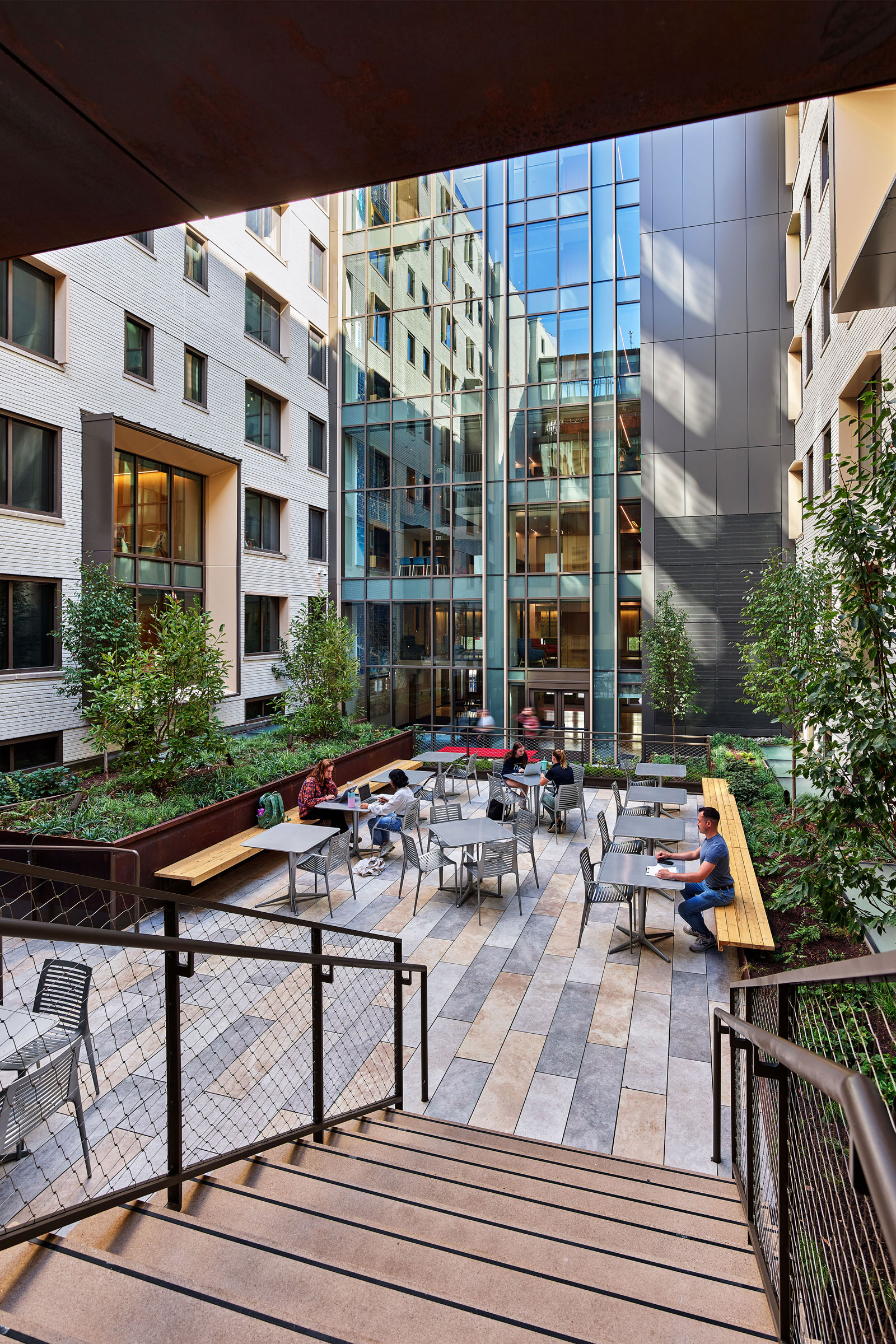Story at a glance:
- George Washington University students are surrounded by light and life thanks to recent renovation by VMDO Architects.
- The architecture team carved a new courtyard to revitalize an almost century-old student residence.
Just four blocks away from the White House, students at George Washington University can find themselves immersed in a garden in the city.
But it wasn’t always this way. A few years ago, students had a lot of complaints about the first-year residence Thurston Hall—from slow elevators to moldy bathrooms. A recent renovation by VMDO Architects reinvigorated life to this 1929 brick building.
Courtyard Transformation
- Students studying inside can see outside and feel the contagious energy from the courtyard. Photo by Alan Karchmer
- The project added more than 4,000 square feet of intensive and extensive green roofs. Plants are watered using captured rainwater. Photo by Alan Karchmer
The Thurston Hall renovation started with one bold question: What possibilities open up by carving away a portion of the building?
Going into the project, the design team heard recurring themes from their client, including the university’s mission of “spark, energize, develop, and belong.” The design team was inspired by the existing light well in the building. “We asked ourselves, ‘What if the sun allowed us to bring that spark and vitality that this space is lacking right now?,’” says Andres Pacheco, a senior associate at VMDO.
Although the lightwell was visible from some student rooms, the space was not accessible to the students. The design team thought if they removed a portion of the south-facing facade of the lightwell, they could create a courtyard that brings more light to the student residence while creating an inviting social space. “It’s an adventurous, bold move to pitch to an owner to take away some thousands of square feet and a number of existing bedrooms to allow you to make the whole place come alive,” says Joe Atkins, a principal at VMDO.
But their client was thrilled by the possibility. “People were excited about taking this dark and dirty courtyard and turning into the building’s heart,” says Michelle Amt, director of sustainability and inclusion at VMDO.
Orientation

The exterior of the historic Thurston Hall at George Washington University. Photo by Alan Karchmer
Starting from that clear vision and the first decision to remove the south-facing lightwell facade, many of the other design choices fell into place naturally. “The building was already laying out where we can make the biggest impact,” Pacheco says.
The orientation allows lots of natural daylight while simultaneously providing shade. Opening up the courtyard also presented an opportunity to add vegetation to the space. The design team was intentional with the material they chose for the courtyard and the story it would tell. With terraces at different levels in the north-south direction, they wanted to create an effect of cascading greenery. To complement that they used earthy-colored cladding to create a warm, natural feeling.
In the east-west direction they painted the original red brick walls with a lighter color to help reflect more light.
Lighting
With daylight an important priority, the projects used thermally broken windows with high-performance glazing units to allow light in while maintaining energy efficiency. Bringing in more natural light to interior spaces like corridors and common spaces, the project achieved a reduced lighting power density by 65%.
Community and Wellness
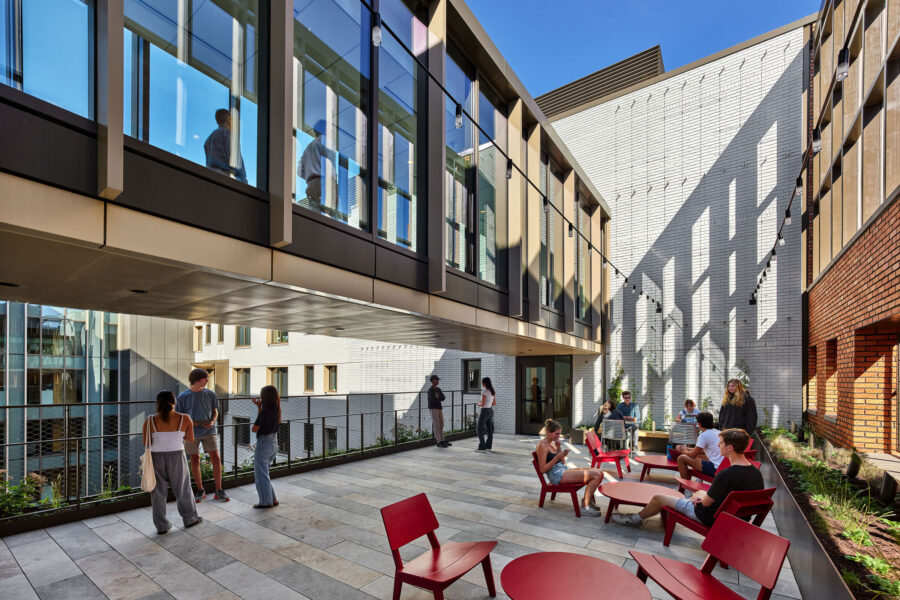
Research shows that college students who are able to connect with one another experience better overall well-being and academic success. Photo by Alan Karchmer
The changes to the courtyard to enhance daylight and provide more community spaces also aligns with the health and wellness goals of the project. “We know that from a number of different mental health surveys that the primary drivers of mental health problems for students is a lack of community and social isolation,” Amt says. Students’ physical environments play a large role in that.
Prior to the renovation, stepping into Thurston felt like going through an endless loop of doors and dark hallways. There were very little community spaces. In the new design the team created different scales of community. Everything revolves around the giant courtyard, but there are also two-story kitchens that connect between floors, large study areas that allow students to study together, and smaller nooks that feel more intimate. “You have all these spaces of prospect and refuge that give you this aspect of security and belonging,” Amt says.
Air Quality
Before the renovation Thurston Hall was not ventilated. Although this is common for older residence halls, research shows that air quality affects cognitive function, depression, and anxiety. The renovation adds a dedicated outdoor air system to bring in fresh air. CO2 levels were averaging around 1600 ppm and reached as high as 3000 ppm before the renovation, now staying below 900 ppm.
Water
The renovation also added a 3,000-cubic-foot cistern to capture rainwater, allowing Thurston Hall to use 40% less potable water than the standard residence hall. This is a significant feat, considering that Thurston Hall has all-gendered bathrooms, Amt says. “Because we don’t have urinals, we’re not able to get the extreme water reduction numbers you would normally see in a LEED project.”
Energy Efficiency
The renovation added insulation to the exterior walls and roof and improved the airtightness. The project added water source heat pumps but had to keep the existing boilers because they were shared with another building. Still, the renovated building used 38% less energy than the average residence and dining hall.
Embodied Carbon
The renovated building keeps 80% of the existing walls, floors, and roof. “A good deal of the existing structure was reused and augmented to bring it to current standards,” Amt says. “We’re reinvigorating this old structure with new life which prepares it for another 100 years in a much more human-centric, 21st century approach to creating community in residence halls.”
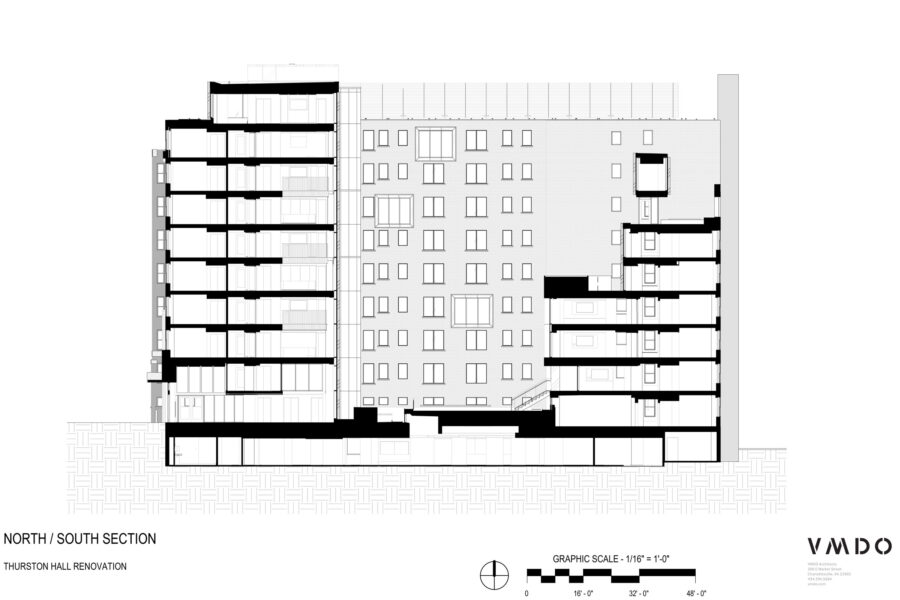
Drawing courtesy of VMDO Architects
Project Details
Project: George Washington University Thurston Hall
Location: Washington, D.C.
Completion: August 2022
Size: 200,000 square feet
Architect: VMDO Architects
Contractor: Clark Construction Company
Interior Designer: SMBW
Wayfinding & Environmental Graphics: Iconograph
Landscape Architect: VMDO, Siteworks
Civil Engineer: Wiles Mensch
Mechanical Engineer: CMTA
Structural Engineer: Springpoint
Geotechnical Engineer: ECS
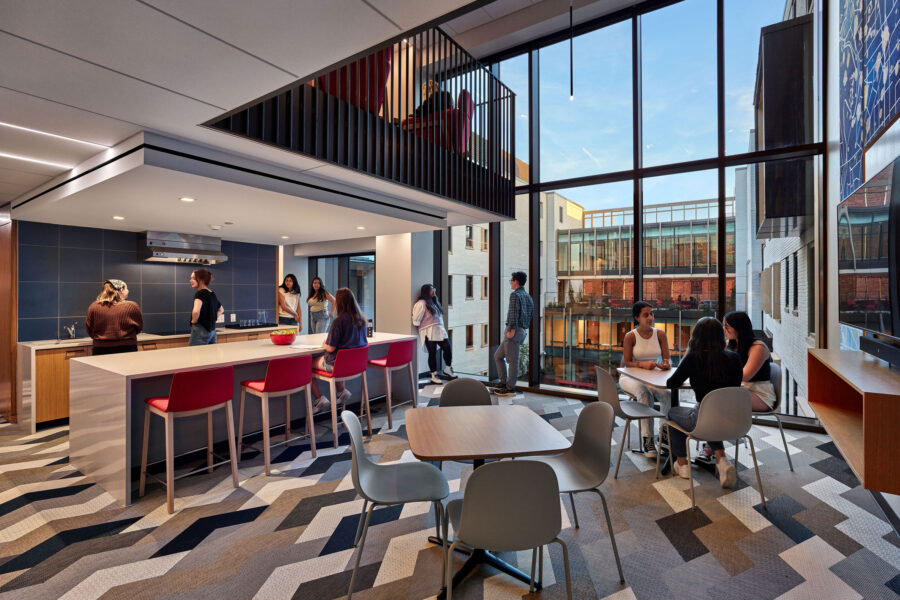
The design team wanted to make the interiors feel like home—cozy and welcoming. This informed warm color choices, with no stark whites or finishes that would feel too austere. The color palette incorporates the school’s colors (blue and buff) to align with the university’s brand image, with occasional pops of color to make the spaces feel age-appropriate. Photo by Alan Karchmer
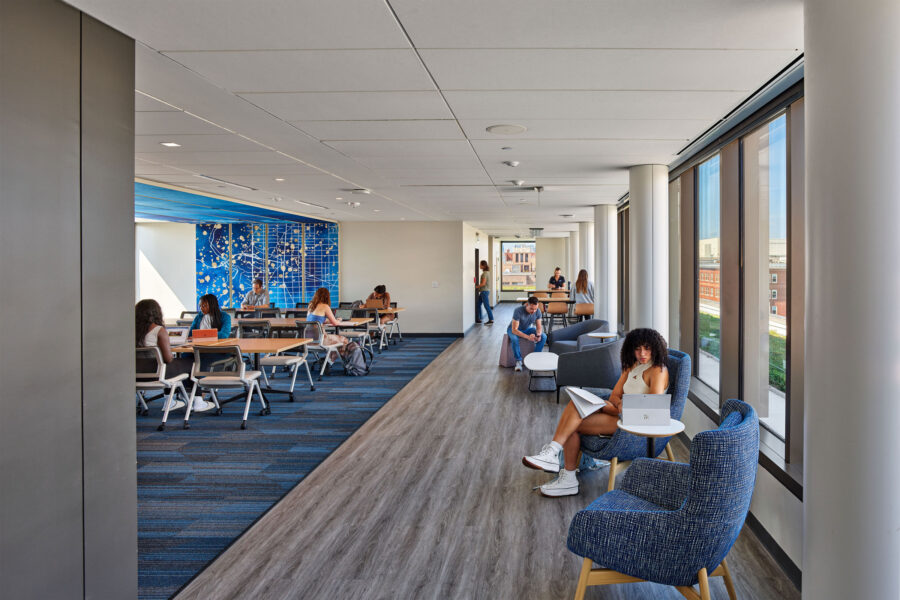
The architects worked to curate a variety of spaces to support a range of student activities at different scales, from places for one person to take a phone call to larger spaces for group studying and interaction. Photo by Alan Karchmer



